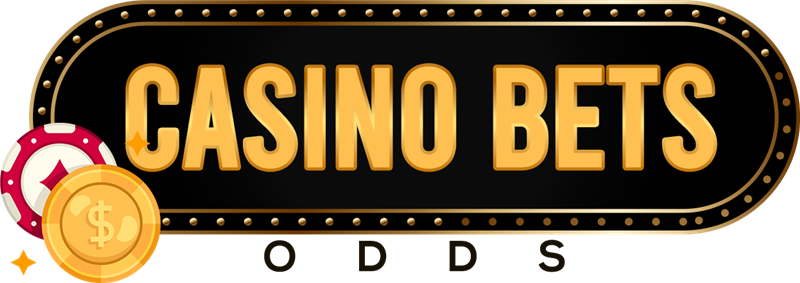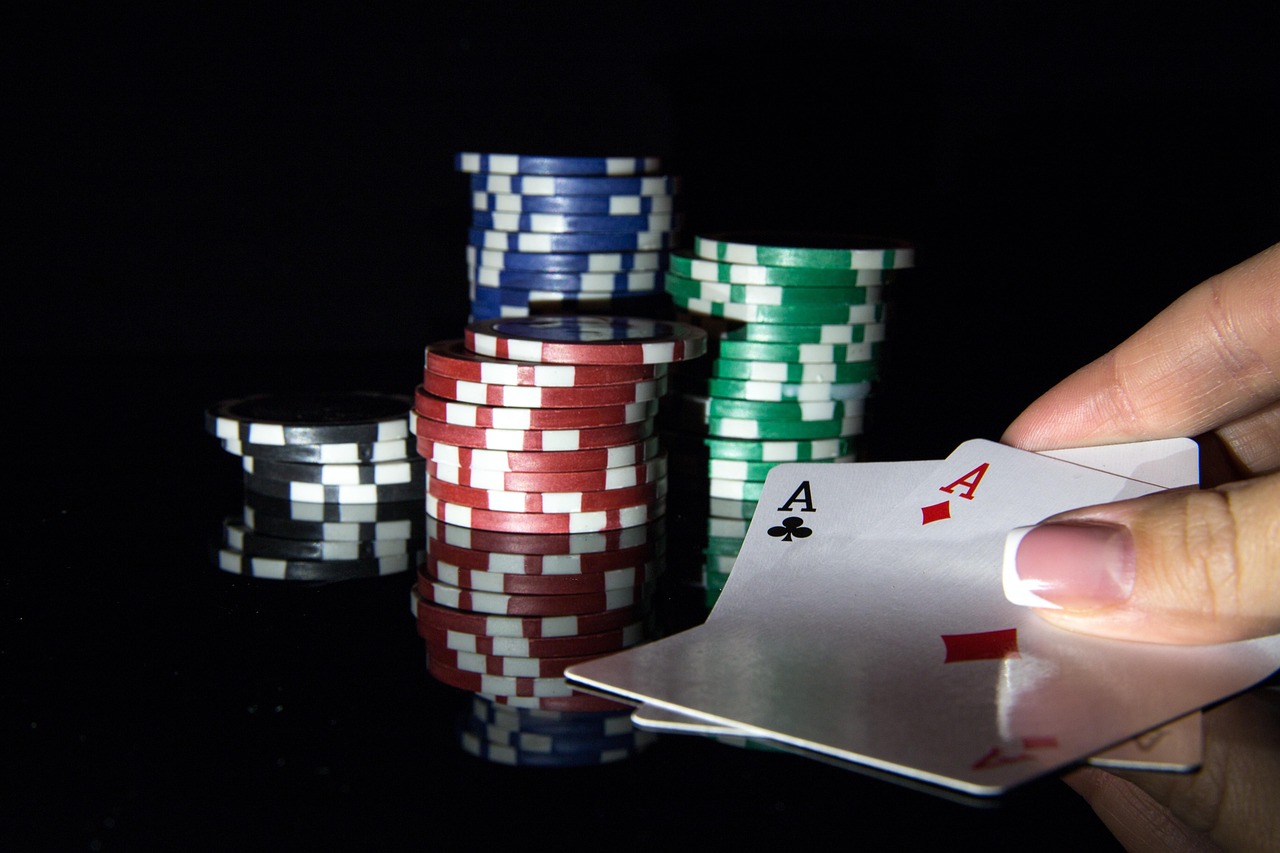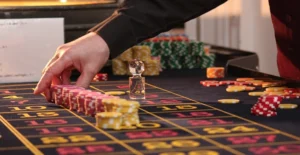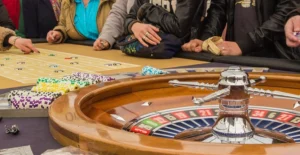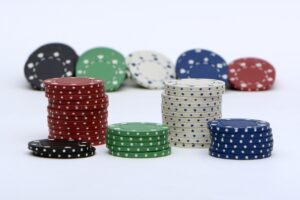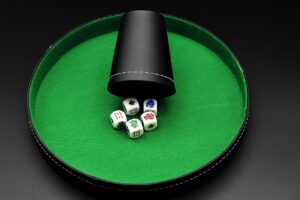Learning how to play Three Card Poker can be a lot of fun, especially if you’re just starting. It’s a pretty straightforward game, but having a good plan can help you out. This guide will walk you through some simple tips and tricks, so you can feel more confident at the table and win a bit more. We’ll cover the basics of three-card poker betting strategy, from understanding your cards to making smart decisions about when to bet and when to fold. No need for complicated math here, just clear advice to get you going.
Key Takeaways
- Always bet on hands that are Queen-6-4 or better.
- Folding hands weaker than Queen-6-4 is usually the best move.
- Understand how hand rankings work in Three Card Poker, especially that a straight beats a flush.
- Side bets like Pair Plus can add excitement, but they often have a higher house edge.
- Setting a budget and sticking to it is important for managing your money while playing.
Introduction to Three-Card Poker Strategy for Beginners
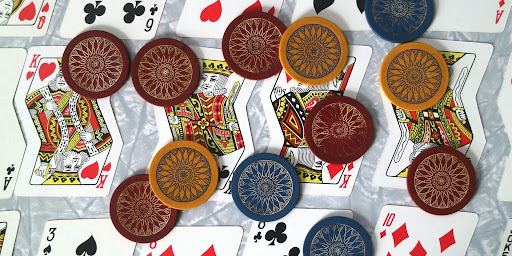
So, you’re looking to get into Three Card Poker? Awesome! It’s a fast-paced game that’s easy to learn, but like any poker variant, a little strategy can go a long way. Forget those drawn-out Texas Hold’em sessions; this is about quick decisions and maximizing your chances with just three cards. This guide will give you some solid three-card poker strategy tips to get you started.
Think of this as your beginner’s toolkit. We’ll cover the basics, like hand rankings, and then move into the famous Queen 6 4 rule. We’ll also touch on some common mistakes to avoid and how to manage your bankroll. It’s all about making smart choices and having fun while you’re at it.
The goal here isn’t to turn you into a pro overnight, but to give you a solid foundation so you can approach the game with confidence and make informed decisions. Remember, even a basic strategy is better than no strategy at all.
We’ll also briefly discuss the Pair Plus side bet and the Ante Bonus bet, so you know what they are and how they work. Understanding the house edge and RTP (Return to Player) is also important, as it shows why using a strategy matters in the long run. Finally, we’ll point you towards some practice tools, like free play and simulators, so you can hone your skills without risking real money. Let’s dive in and learn how to play three-card poker.
Understanding Hand Rankings in Three-Card Poker
Okay, so before we get into the nitty-gritty of betting, it’s super important to know what beats what in Three Card Poker. It’s similar to regular poker, but there are some key differences since you’re only dealing with three cards. Knowing these rankings cold is the first step to making smart decisions at the table.
Here’s a breakdown:
- Straight Flush: This is the best hand you can get. It’s three cards in a sequence, all of the same suit (e.g., 5-6-7 of hearts).
- Three of a Kind: Three cards of the same rank (e.g., three Queens).
- Straight: Three cards in a sequence, but not all of the same suit (e.g., 4 of clubs, 5 of diamonds, 6 of spades).
- Flush: Three cards of the same suit, but not in a sequence (e.g., 2-5-9 of diamonds).
- Pair: Two cards of the same rank (e.g., two 8s).
- High Card: If you don’t have any of the above, your hand is ranked by the highest card. An Ace is high.
It’s worth noting that in Three Card Poker, a straight is ranked higher than a flush. This is different from standard poker, so don’t let that trip you up.
If two players have the same type of hand (like a pair), the higher-ranking cards determine the winner. For example, a pair of Kings beats a pair of Queens. If the pairs are the same, then the kicker (the third card) is used to break the tie. Similarly, with high card hands, you compare the highest card first, then the second-highest, and finally the third if needed. This is important when considering ante bonus bet payouts.
The Queen 6 4 Rule: Basic Ante Play Betting Strategy
This is where things get simple. The Queen 6 4 rule is your bread and butter for basic Three Card Poker strategy. It’s easy to remember and will keep you from making too many costly mistakes when you’re just starting. Basically, it tells you when to bet and when to fold when you’ve made the Ante bet.
The core idea is this: if your hand is Queen-6-4 or higher, you bet. If it’s lower, you fold.
Think of it as a minimum requirement. You wouldn’t try to build a house on a shaky foundation, right? Same here. Queen-6-4 is your solid base. Anything less, and you’re probably throwing money away.
Here’s a breakdown:
- Queen-6-4 or better: Bet (make the ‘Play’ bet, which is equal to your Ante).
- Lower than Queen-6-4: Fold (you lose your Ante, but that’s better than losing more).
- Don’t overthink it: Seriously, at this stage, just stick to the rule. Forget about bluffing or trying to be fancy. Keep it simple.
This rule isn’t perfect, and there are more advanced strategies, but it’s a great starting point. It helps you avoid the worst hands and gives you a decent chance of winning when you do bet. Remember, the goal is to minimize losses and maximize potential wins, and this rule helps you do that.
Let’s say you get dealt Queen-7-3. That’s better than Queen-6-4 because the 7 is higher than the 6. So, you’d bet. But if you get Queen-5-2, you’d fold. It’s all about that second card when you have a Queen high. If you want to play Three Card Poker for free, you can practice this strategy.
When to Bet: Play Only Queen 6 4 or Higher
This is where the rubber meets the road. You’ve ante up, you’ve got your three cards, now what? The most basic and widely accepted strategy in Three Card Poker revolves around the “Queen 6 4” rule. This rule dictates that you should only make the Play bet if your hand is Queen-6-4 or higher.
What does “Queen 6 4 or higher” actually mean? It’s not just about having those specific cards. It’s about having a hand that ranks at least as high as a Queen-6-4. Remember, poker hands are ranked by the highest card first, then the second highest, and so on. So, a Queen-7-3 is better than a Queen-6-4 because the 7 beats the 6. Similarly, a King-high hand is better than any Queen-high hand.
Think of the Queen-6-4 rule as your baseline. If your hand is weaker than this, folding is generally the best option. It might feel like you’re throwing money away, but in the long run, it will save you from making bets on hands that are statistically likely to lose.
Here’s a simple breakdown:
- Raise (Make the Play Bet): If your hand is Queen-6-4 or better.
- Fold: If your hand is worse than Queen-6-4.
It’s that simple. Sticking to this rule will drastically improve your odds compared to just guessing or playing every hand. It’s a solid foundation to build upon as you gain more experience with the game. Remember, consistent winning requires strategic thinking and game knowledge.
Advanced Ante Play Guidelines for Queen High Hands
So, you’ve got the basics down – play Queen 6 4 or better. But what happens when you’re staring at a Queen-high hand that isn’t quite a slam dunk? That’s where things get interesting. It’s time to move beyond the simple rule and consider some more nuanced situations.
The strength of your “kicker” cards (the other cards in your hand besides the Queen) becomes much more important.
Let’s say you’re holding a Q-8-5. Is that better or worse than a Q-7-2? The Q-8-5 is the stronger hand. But how much stronger does it need to be to justify a play bet?
- Consider the other players at the table. Are they aggressive or passive? If they’re aggressive, you might want to be a little tighter with your Queen-high hands.
- Think about the potential for improvement. Does your hand have any flush or straight draws? If so, it might be worth playing even a weaker Queen-high hand.
- Pay attention to the dealer’s up card (if visible). This can give you some information about the dealer’s potential hand.
Remember, Three Card Poker is a game of incomplete information. You’re never going to know exactly what the dealer is holding. The goal is to make the best decision possible with the information you have. Don’t be afraid to fold a Queen-high hand if you think the odds are against you. It’s better to lose your Ante bet than to throw good money after bad.
Here’s a simple table to help you visualize how hand rankings work:
| Hand | Example |
| Straight Flush | Q-J-10 |
| Three of a Kind | Q-Q-Q |
| Straight | 7-8-9 |
| Flush | 2-5-8 |
| Pair | 2-2-K |
| High Card | A-K-J |
What to Avoid: Folding Queen High with Weak Kickers
It’s tempting to rigidly stick to the Queen 6 4 rule, but sometimes, folding a Queen-high hand can be a mistake, especially when your “kickers” (the other cards in your hand) aren’t terrible. Let’s explore when you might want to reconsider that fold.
Sometimes, you might have a Queen with a decent second card. Don’t automatically toss away a Queen-high hand without considering the other cards.
Here’s why:
- Marginal Hands: Three Card Poker is full of marginal hands. The dealer needs a Queen-high to qualify, so even a slightly better Queen-high hand than theirs gives you a good shot at winning.
- The Ante Bonus: Remember, you get paid an ante bonus for certain strong hands, regardless of whether the dealer qualifies or not. While a weak Queen-high won’t trigger this, it’s still a factor in your overall strategy.
- Opponent Psychology: While Three Card Poker is primarily a game against the house, understanding basic probability can give you an edge. Folding too often makes you predictable.
It’s a balancing act. You don’t want to throw good money after bad with a truly awful hand, but being overly cautious can cost you opportunities. Think about the potential payout versus the risk before you fold.
Consider these scenarios:
- You have Q-8-2. This is better than Q-6-4, so you should bet.
- You have Q-7-5. This is also better than Q-6-4, so you should bet.
- You have Q-2-3. This is worse than Q-6-4, so you should fold.
It’s all about understanding the odds and making informed decisions. Don’t just blindly follow the rule; think about the specific cards you’re holding. Remember to manage your bankroll effectively to withstand any losses.
Pair Plus Side Bet: How It Works & When to Play
The Pair Plus side bet in Three Card Poker adds a layer of excitement, but it’s important to understand how it works before jumping in. Unlike the main Ante Bet, which involves playing against the dealer, the Pair Plus bet is solely based on the hand you’re dealt. If your three-card hand contains a pair or better, you win, regardless of the dealer’s hand. The payout depends on the strength of your hand, with higher-ranking hands yielding larger payouts.
Here’s a breakdown of how it typically works:
- You place your Pair Plus bet before receiving your cards.
- You are dealt three cards.
- If your hand contains a pair or better (pair, flush, straight, three-of-a-kind, or straight flush), you win.
- The payout is determined by a pre-defined pay table.
Let’s look at a common pay table for the Pair Plus bet:
| Hand | Payout | Example |
| Straight Flush | 40:1 | A, 2, 3 suited |
| Three of a Kind | 30:1 | Three Queens |
| Straight | 6:1 | 4, 5, 6 |
| Flush | 3:1 | K, 8, 3 all hearts|
| Pair | 1:1 | Two 7s |
When to play the Pair Plus bet is a matter of personal preference and risk tolerance. Some players enjoy the added excitement and potential for a large payout, while others prefer to stick to the main ante bet. However, it’s important to remember that the Pair Plus bet has a higher house edge than the Ante Bet. The house edge can vary slightly depending on the specific pay table used by the casino, but it’s generally around 7-8%.
While the Pair Plus bet can be tempting due to the potential for large payouts, it’s crucial to understand that it’s a side bet with a significant house edge. This means that, over the long run, you’re more likely to lose money on the Pair Plus bet than on the main ante bet. Therefore, it’s important to manage your bankroll carefully and avoid betting more than you can afford to lose.
Ante Bonus Bet Explained: Extra Payouts for Strong Hands
The Ante Bonus in Three Card Poker is a cool feature that gives you extra payouts just for having a good hand, regardless of what the dealer has. It’s like a pat on the back for getting dealt something awesome. This is separate from the regular Ante and Play bets, which depend on beating the dealer’s hand. Let’s break down how it works.
The Ante Bonus pays out when you have a straight or better. This means even if the dealer doesn’t qualify (doesn’t have a Queen-high or better) or you lose to the dealer, you still get the bonus payout if your hand is strong enough.
Here’s a simplified example of a common Ante Bonus pay table:
| Hand | Payout |
| Straight Flush | 5:1 |
| Three of a Kind | 4:1 |
| Straight | 1:1 |
Keep in mind that pay tables can vary from casino to casino, so it’s always a good idea to check the specific rules before you start playing. Some casinos might offer slightly different payouts for each hand.
The Ante Bonus adds an extra layer of excitement to Three Card Poker. It rewards players for strong hands, even when they don’t win the main bet. However, it’s important to remember that the house edge is still a factor, and relying solely on the Ante Bonus isn’t a winning strategy.
Here are a few things to keep in mind about the Ante Bonus:
- It’s paid out regardless of the dealer’s hand.
- Payouts vary depending on the casino’s pay table.
- It only applies to hands of a straight or better.
While the Ante Bonus can be a nice boost to your winnings, it’s crucial to focus on the overall strategy of the game, including when to bet and when to fold. Don’t let the potential for a bonus payout cloud your judgment!
House Edge & RTP: Why Strategy Matters
Okay, let’s talk about why you need a strategy in Three Card Poker. It all boils down to the house edge and the Return to Player (RTP). Basically, these numbers tell you how much the casino expects to win from you in the long run, and how much you can expect to get back. Ignoring these numbers is like driving a car without looking at the gas gauge – you might get somewhere, but you’ll probably run out of gas (or money) pretty quickly.
Understanding these concepts is key to making smart betting decisions.
Think of it this way: every game in the casino has a built-in advantage for the house. That’s the house edge. It’s the percentage of each bet that the casino expects to keep over time. The RTP is the opposite – it’s the percentage of wagers that the game is expected to return to players over time. So, a game with a 3% house edge has a 97% RTP. The higher the RTP, the better your chances of winning (or, at least, losing less).
Here’s a simple breakdown:
- House Edge: The casino’s advantage, expressed as a percentage.
- RTP: The percentage of wagered money a game returns to players over time.
- Strategy Impact: Using a good strategy lowers the house edge and increases your RTP.
Without a solid strategy, you’re essentially handing over more money to the casino than you need to. A good strategy helps you make informed decisions, minimizing your losses and maximizing your potential winnings. It’s not about guaranteeing a win every time (that’s impossible), but about improving your odds over the long haul.
Different bets in Three Card Poker have different house edges. For example, the Pair Plus bet often has a higher house edge than the Ante bet, meaning it’s riskier. Knowing this helps you decide where to put your money. Also, remember that the house edge can vary based on the specific rules of the game, so always check the rules before you start playing.
Here’s a quick example of how strategy affects the house edge. Playing completely randomly in Three Card Poker (raising on everything) results in a house edge of around 7.65%. But, using the basic Queen 6 4 strategy, you can lower that to around 3.37%. That’s a huge difference!
Effective Bankroll Management for Beginners
Okay, so you’re getting into Three Card Poker. Awesome! But before you start dreaming of big wins, let’s talk about something super important: managing your money. Think of your bankroll as your ammo – you don’t want to run out before the battle’s even started. Good bankroll management isn’t just about limiting losses; it’s about extending your playtime and increasing your chances of hitting a winning streak.
Here’s the deal. You need a plan. Just throwing money at the table and hoping for the best is a recipe for disaster. Let’s break down how to keep your head above water and maybe even come out ahead.
- Set a Budget: Decide how much you’re willing to spend before you even think about playing. This is money you can afford to lose without it impacting your life. Seriously, don’t dip into rent money or grocery funds. This is your entertainment budget, plain and simple.
- Define Unit Size: A ‘unit’ is basically your standard bet size. A good rule of thumb is to make one unit equal to 1-2% of your total bankroll. So, if you have $200, your unit size should be $2-$4. This helps you weather losing streaks without blowing your whole wad.
- Know When to Stop: This is HUGE. Set both a win limit and a loss limit. If you hit your win limit, cash out and celebrate! If you hit your loss limit, walk away. Don’t chase losses – it almost always makes things worse. Remember, the casino will always be there tomorrow.
It’s easy to get caught up in the excitement of the game, but staying disciplined is key. Think of bankroll management as a skill, just like learning the hand rankings. The better you are at it, the longer you’ll be able to play and the more fun you’ll have. Don’t let emotions dictate your decisions. Stick to your plan, and you’ll be in a much better position to enjoy the game responsibly.
Consider this example:
| Bankroll | Unit Size (1%) | Unit Size (2%) |
| $100 | $1 | $2 |
| $200 | $2 | $4 |
| $500 | $5 | $10 |
| $1000 | $10 | $20 |
This table shows how your bet size should change based on your bankroll. Sticking to these guidelines will help you manage risk and extend your playtime. Remember to check out gambling videos for more tips.
Avoiding Common Mistakes: Side Bets & Emotion
It’s easy to get carried away when playing Three Card Poker, especially with the allure of side bets and the rollercoaster of emotions that come with gambling. Let’s break down how to avoid some common pitfalls.
The Siren Song of Side Bets
Side bets, like Pair Plus and the Ante Bonus, can seem tempting because of their potentially high payouts. However, they often come with a significantly higher house edge than the main game. Focusing solely on the ante-play wager is generally a more sound strategy.
Consider this simplified example:
| Bet Type | House Edge |
| Ante-Play | 3.37% |
| Pair Plus | 7.28% |
As you can see, the house has a much bigger advantage on the Pair Plus bet. While a big win on a side bet is exciting, the odds are stacked against you in the long run. It’s like buying a lottery ticket – fun to dream, but not a reliable way to make money. If you must play, stick to the minimum bet. Some progressive side bets have a house edge of over 18%.
Taming Your Emotions
Poker, even a simplified version like Three Card Poker, can be emotionally charged. Winning streaks can make you feel invincible, while losing streaks can lead to frustration and poor decisions. Here are some tips for keeping your emotions in check:
- Set a budget and stick to it: Decide how much you’re willing to lose before you even start playing, and don’t exceed that amount.
- Take breaks: Step away from the table if you’re feeling overwhelmed or tilted. A clear head is essential for making good decisions.
- Don’t chase losses: Trying to win back what you’ve lost is a recipe for disaster. Accept that losses are part of the game and move on.
Remember, Three Card Poker should be fun. If you’re not enjoying yourself, it’s time to stop. Don’t let emotions dictate your betting strategy. Stick to the plan, and you’ll have a much better chance of success (and a more enjoyable experience).
Recognizing Tilt and Its Impact
“Tilt” is a poker term for when emotions negatively affect your game. Signs of tilt include:
- Making rash decisions.
- Betting larger amounts than usual.
- Playing hands you normally wouldn’t.
If you recognize these signs, stop playing immediately. It’s better to walk away and come back another day than to continue making mistakes fueled by emotion. Remember to think in terms of hand ranges and not individual hands.
Practice Tools: Free Play, Simulators & Live Dealers
Okay, so you’ve got the basics down. You know about hand rankings, the Queen 6 4 rule, and when to bet. Now it’s time to put that knowledge to the test. Luckily, there are a bunch of ways to practice Three Card Poker without risking real money, or to get the real experience with low stakes.
Using practice tools is a great way to build confidence and refine your strategy.
- Free Online Games: Many websites and apps offer free versions of Three Card Poker. These are perfect for getting a feel for the game’s pace and practicing your betting decisions. You can play hundreds of hands without any financial risk. This is a great way to get familiar with casino table games before you play for real.
- Poker Simulators: These tools let you simulate different scenarios and test your strategy against various hand combinations. Some simulators even provide feedback on your decisions, helping you identify areas for improvement. They can be a bit more advanced than free games, but they’re worth exploring as you get more serious.
- Live Dealer Games (Low Stakes): If you’re craving the real casino experience, look for online casinos that offer live dealer Three Card Poker with low minimum bets. This allows you to interact with a real dealer and other players while still keeping the financial risk manageable. It’s the closest you can get to a real casino without leaving your house.
It’s important to remember that even the best strategy can’t guarantee wins every time. Three Card Poker, like all casino games, involves an element of chance. The goal of practicing is to minimize your losses and maximize your potential winnings over the long run.
Putting It All Together: Beginner’s Checklist Strategy
Okay, so you’ve absorbed a bunch of info about Three Card Poker. Now, how do you use it at the table? It’s easy to get overwhelmed, so let’s break it down into a simple checklist you can run through before making any decisions. This isn’t about becoming a pro overnight; it’s about making fewer mistakes and having a better shot at winning while you learn the ropes. Remember to check out the Three Card Poker guide for more information.
Pre-Game Prep
- Bankroll Check: Decide how much you’re willing to spend before you even sit down. Seriously, stick to it. No chasing losses. This is your “fun money,” and when it’s gone, it’s gone. Consider setting a win limit, too – a point where you walk away with your profits.
- Know the Hand Rankings: Print out a cheat sheet if you need to! There’s no shame in referencing them until you’ve memorized them. Knowing that a straight beats a flush in this game is important.
- Understand the Table Limits: Make sure the minimum and maximum bets fit your bankroll. Don’t sit at a table where you can only afford a few hands.
Ante Play Decision
- Queen 6 4 Rule: This is your bread and butter. Do you have Queen-6-4 or higher? If yes, play. If no, fold. It’s not perfect, but it’s a solid starting point. Remember, this is the most basic Three Card Poker strategy.
- Kicker Consideration (Queen High): If you have a Queen-high hand, think about your kickers. Are they decent? If you have something like Q-8-7, it’s a stronger play than Q-6-5. But don’t overthink it too much at this stage.
- Avoid Weak Queen High Hands: Don’t be tempted to play Queen-high hands with very low kickers just because you’re bored. Folding is often the smarter move.
Pair Plus & Ante Bonus Bets
- Pair Plus Caution: Be very careful with this bet. The house edge is high. If you’re going to play it, understand the payouts and the odds. Maybe limit yourself to a small, fixed amount per hand.
- Ante Bonus Awareness: Remember that you get paid extra for strong hands (straight, three-of-a-kind, straight flush) even if the dealer doesn’t qualify. This is a nice bonus, but don’t let it influence your basic strategy.
During the Game
- Stick to the Plan: Don’t let emotions dictate your decisions. If you’re on a losing streak, don’t start making crazy bets to try and win it back. Take a break if you need to.
- Observe Other Players: See what hands they’re playing and how they’re betting. You might pick up some useful information (or at least learn what not to do).
- Don’t Be Afraid to Fold: Folding is not a sign of weakness. It’s a sign of intelligence. Sometimes the best way to win is to avoid losing.
Remember, Three Card Poker is a game of chance. There’s no guaranteed way to win every time. The goal is to make smart decisions, manage your bankroll effectively, and have fun. Don’t treat it like a job; treat it like entertainment.
Post-Game Analysis
- Review Your Decisions: After you’re done playing, think about the hands you played and the decisions you made. Did you stick to your strategy? Did you make any mistakes? What could you have done differently?
- Track Your Results: Keep a simple record of your wins and losses. This will help you see if your strategy is working and identify areas where you need to improve.
- Adjust as Needed: Don’t be afraid to tweak your strategy as you gain experience. What works for one person might not work for another. Find what works best for you.
By following this checklist, you’ll be well on your way to becoming a more confident and successful Three Card Poker player. Good luck!
Frequently Asked Questions
What exactly is Three Card Poker?
Three Card Poker is a casino game where you play against the dealer, not other players. You get three cards, and so does the dealer. The goal is to have a better poker hand than the dealer to win.
What’s the best basic strategy for new players?
The most important rule for beginners is the ‘Queen 6 4’ rule. This means you should usually bet more (raise) if your hand is Queen, 6, 4 or better. If your hand is worse than that, you should usually give up (fold).
Are the hand rankings different from regular poker?
In Three Card Poker, a Straight (three cards in a row, like 4-5-6) is actually better than a Flush (three cards of the same suit, like three hearts). This is different from regular poker, so keep an eye on it!
What is the ‘Pair Plus’ bet?
The ‘Pair Plus’ bet is an extra bet you can make. You win this bet if your three cards have a pair or something even better (like a flush or straight), no matter what the dealer has. It’s a fun side bet, but it costs extra.
How does the ‘Ante Bonus’ work?
The ‘Ante Bonus’ is another way to win extra money. If you get a really strong hand, like a Straight, Three of a Kind, or a Straight Flush, you get a bonus payout on your first bet (the ante), even if the dealer has a better hand or doesn’t ‘qualify’.
What do ‘House Edge’ and ‘RTP’ mean?
The ‘house edge’ is the small advantage the casino has over players. ‘RTP’ means ‘Return to Player,’ which is how much money, on average, a game pays back to players over time. Using a good strategy helps lower the house edge and increase your RTP, meaning you lose less money in the long run.
Why is managing your money important?
Managing your money means deciding how much you’re willing to spend before you start playing and sticking to that limit. For example, if you have $300, you might decide to only bet $10 per hand. This helps you play longer and not lose too much too quickly.
Where can I practice playing Three Card Poker for free?
Many online casinos offer free versions of Three Card Poker. You can also find simulator apps that let you practice without using real money. These are great ways to get comfortable with the game and try out strategies before playing for real.
Daniel Chase is a seasoned casino analyst and iGaming writer with over 10 years of experience in the online gambling industry. He specializes in game strategy, casino odds, and player-focused reviews. Daniel is passionate about helping players make smarter decisions through transparency, real data, and honest insight.
